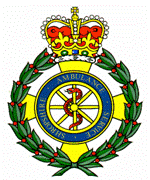St Martins Community First Responders:
- Do you know who they are and what they do?
St. Martins Community First Responders
The Rôle of the Community First Responder St. Martins lies 8 miles across country from the ambulance station and 25 miles from Shrewsbury A&E department. It takes an ambulance on lights and sirens sixteen minutes to reach here assuming it is on station and has a clear run. Government targets dictate an 8 minute response time for serious emergencies. We know that heart attack victims deteriorate at 10% per minute, so what price a Community First Responder? There are three of us in our village and between us we are available at a moment`s notice on average 280 of the 288 hours a week. I cover mornings and weekends mostly, while John covers afternoons and evenings. Our “patch” has a radius of around 10 miles, overlapping with other CFRs in outlying villages and in Oswestry. We are formally trained by the West Midlands Ambulance Service over a period of two months, spending a couple of shifts on the ambulances before becoming operational. Our emergency equipment, which includes a defibrillator, is provided, together with overalls and a mobile phone and/or radio. When a 999 call is made from our area Ambulance Control rings to send us on our way at the same moment as the nearest ambulance is despatched. CFRs work alone. Our task is to assess the situation, provide what treatment we can including basic life support when necessary, prepare the scene for the arrival of the ambulance crews, offer comfort and reassurance to the patient and relatives, and hand over to the crew when they arrive. Technically, our job is over at that point but often there is further help to be given, fetching and carrying, filling in the forms, keeping the relatives informed, etc. We can`t diagnose, of course, but we can treat the symptoms of many medical and traumatic emergencies and the sooner this treatment starts the better the prognosis for the patient. The job requires sound training, confidence without complacency, calmness and clear thought under pressure, tact, compassion, absolute confidentiality, and a thick skin. Experience makes for a more efficient CFR and there is something new to be learned from every job. Most jobs are straightforward but occasionally we meet with something very funny, very sad, very nasty or very frightening. We are not isolated, however. Our controlling paramedic,
Terry Foster, keeps a close eye on us, offers practical and psychological support, arranges monthly training meetings and updates when required. We are also in contact with the other CFRs (in Gobowen, Oswestry, and Whittington) constantly so we can laugh past the difficulties and talk through the horrors. CFRs are volunteers. They receive no payment at all. They are admired and trusted by their communities and respected by their local ambulance service. When Should I call 999 for an Ambulance? This is often what a relative first says when we reach a location: “Have I done the right thing?“ Usually, the answer is Yes: few people in this area call 999 unnecessarily. We`ve all heard stories of drunks needing taxis and idiots losing their car keys! I have, however, recently met with someone who pushed her very large husband with a very bad leg injury into a very small car and drove him to A&E! An ambulance would have been much more comfortable. 999 will bring you an “Emergency Ambulance.” So, is this an emergency? Remember that the ambulance which arrives will take you to the nearest A&E department. If you go in the ambulance with the patient you will need to find your own way home afterwards. For an accident you could ask yourself if the casualty is fit enough to get into a car and be driven by yourself or a neighbour to hospital? Fingers, hands and arms, superficial injuries … possibly.
For illness, can it wait until morning when the surgery opens, or would a doctor visiting or consulting over the phone (Shropdoc or Newdoc) be more appropriate? If you are not sure you could try NHS Direct but be prepared to use your own judgement, too. You can see the patient and can probably judge how bad things are. You should call 999 immediately if there are chest pains and shortness of breath, loss of function on one side of the body, severe bleeding, loss of consciousness, obvious fractures, spinal or neck trauma.
MARKED CFR CARS In 2011 the Oswestry & District group of CFRs bought two cars to use in place of our own cars. One is based in Oswestry, the other in St Martins. We bought them after considerable fund raising and with the invaluable help of Stans Superstore and the Charlotte Hartey Foundation. We have since been assisted a great deal by Castle Garage of St Martins, too. The St Martins car has recently been replaced with the help of Furrows of Oswestry and we now have a red Skoda Fabia as you can see from the photo. Huge help with the livery was given by Scotprint of Oswestry, and we are very grateful both to them and to Furrows. We have no blue lights or sirens, of course! If the headlights are showing in daytime we are on our way to a 999 call. We won`t be breaking any rules of the road but please help us by allowing us easy passage and access. Kerry Llywarch
 For further information
For further information 